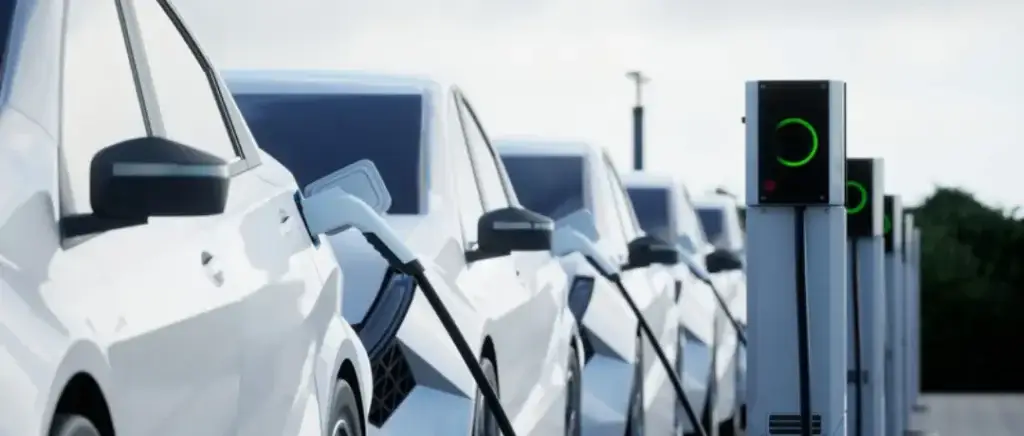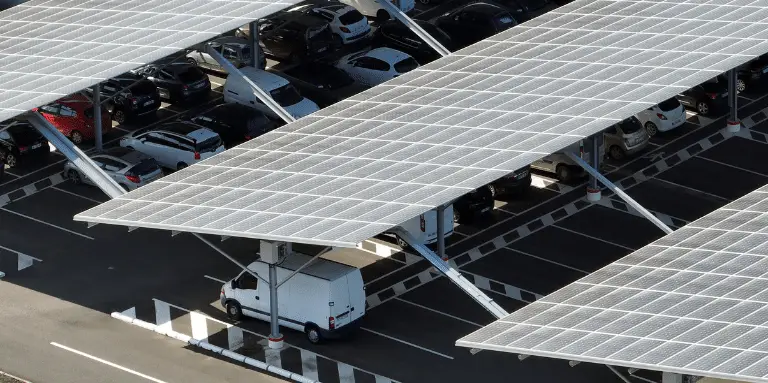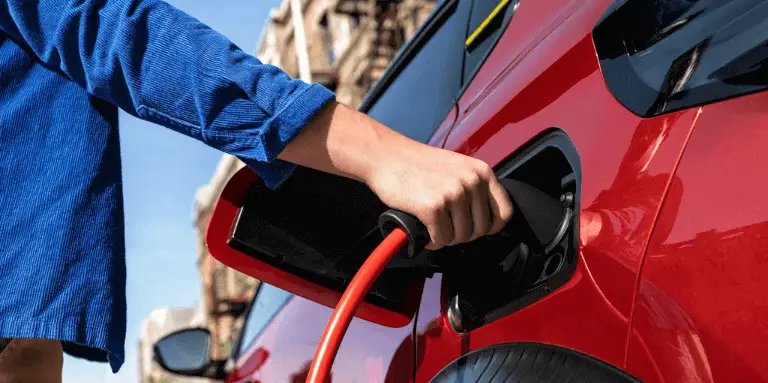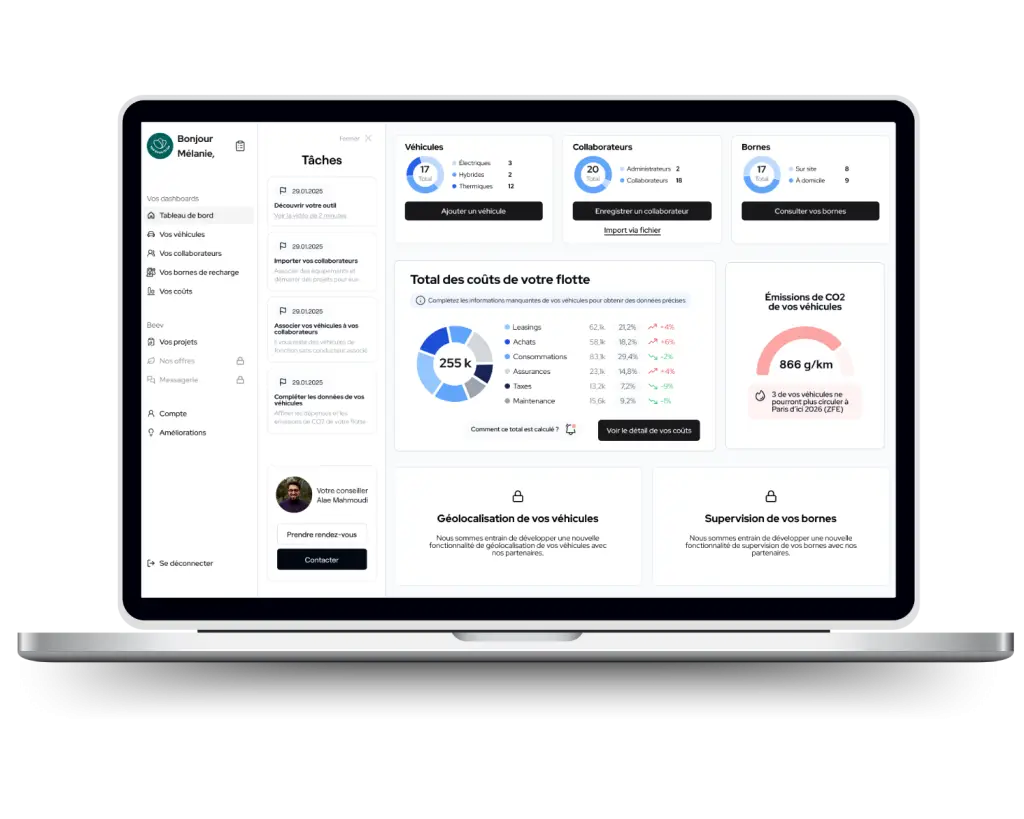Why install recharging points in your company?

Installing charging points is no longer a "nice to have": it has become a strategic necessity for businesses.
1) An increasingly strict legal framework
The law on energy transition for green growth requires new or renovated car parks to be equipped with recharging infrastructure. In addition, fleets of more than 100 vehicles must include 40 % of low-emission models from 2025, and 70 % by 2030.
2) A lever for competitiveness
Offering employees the chance to recharge their batteries means attracting and retaining talented staff, who are turning to electric vehicles on a massive scale. It also means optimising TCO (Total Cost of Ownership), as electricity costs up to 4 times less than fuel.
3) A CSR and brand image asset
An electrified fleet and on-site charging points send out a strong signal to your customers and partners: your company is making a concrete commitment to reducing its carbon footprint. carbon footprint.
In plain English, Installing charging points means turning a regulatory constraint into an economic opportunity and a sustainable competitive advantage.
A guide to installing recharging points on logistics sites
What needs to be analysed before deploying a system? recharging infrastructure ?
Before any installation, a detailed audit is essential. This phase determines the technical and financial success of your infrastructure.
Charging stations must form part of an overall mobility plan. Criteria to be considered :
- Audit of current vehicle fleet: cThis is an exhaustive inventory of the existing vehicle fleet. We need to analyse the company, service and personal vehicles of employees likely to use the terminals.
- User profile : employees, visitors, customers, delivery personnel.
- Types of journeys : daily urban, intercity, long-distance.
- Average parking time : a few hours or a whole day.
- Number of electric vehicles in the fleet today and in 3 to 5 years' time.
- Site electrical capacity : availability of power, possibility of connection to the grid.
- Urban planning and development constraints The installation of bollards must comply with local planning constraints and safety regulations. Parking areas, access for people with reduced mobility, lighting and signage are all elements that need to be taken into account.
Example: an SME with 20 company vehicles, 5 of which are electric today, but a target of 50 % in 2027 must already be anticipating an evolving infrastructure.
What power ratings and types of terminal are best for an electric fleet?

Not all charging points are created equal. The choice depends on parking time and the size of the car. battery vehicles. This selection must be adapted to the specific characteristics of each fleet and to the constraints of use.
- Normal charging point (3.7 to 7.4 kW) Ideal for long-term parking (employees who leave their cars for the day). The main advantage is their ease of installation and low cost. Suitable for light company vehicles, employees' private cars and fleets with moderate mobility needs.
- Accelerated charging station (11 to 22 kW) : the most common compromise for corporate fleets: rapid recharging in just a few hours. They offer greater flexibility of use while maintaining reasonable installation costs. These charging points can be adapted to suit varying needs: full recharging for long missions, quick top-up for short trips.
- Fast charging point (50 to 150 kW and more) : They are mainly reserved for commercial vehicles or fleets with a high turnover (delivery, transport). These charging points can recover 200 to 300 km of fuel.autonomy in 30 minutes, radically transforming the use of electric vehicles. This equipment is ideal for transport companies, logistics fleets and activities requiring maximum vehicle availability.
For a traditional business, accelerated charging points (11-22 kW) are generally the most suitable: they allow you to recover the range you need in just a few hours without blowing the installation budget.
How do you size the number of terminals for use by employees and visitors?

This is a key question: how many bollards should be installed?
Determining the right number of kiosks to install is a key step in guaranteeing the profitability and efficiency of your infrastructure. Too few terminals, and your employees may find themselves waiting; too many at once, and the investment becomes difficult to justify.
The general rule is simple: you have to think in terms of the actual use of the vehicles, the average parking time and the expected growth of the electric fleet.
Here are some practical guidelines:
- Business fleets On average, 1 charging point is recommended for 4 to 5 electric vehicles.
- Employee car parks : plan for at least 10 % of spaces to be equipped with charging points, with a technical reserve to double this figure in the medium term.
- Sites open to the public (customers, visitors) Installing 1 or 2 self-service kiosks has become a brand image standard.
Case in point:
- An SME with 20 vehicles, of which 6 are electric today, will need 2 accelerated charging points (11-22 kW). But if it plans to reach 50 % of electric vehicles in 2027, it makes sense to reserve electrical capacity to add 2 to 3 extra charging points.
- A company with 200 employees with a 150-space car park can start with 15 spaces equipped with charging stations (mainly accelerated), with a possible extension to 30 within 3 years.
Summary table of terminal types and uses
| Type of terminal | Power | Average charge time | Recommended use | Average cost (including installation) |
|---|---|---|---|---|
| Slow | 3.7 - 7.4 kW | 6 to 10 h | Employees working day or night | 1 500 - 2 500 € |
| Accelerated | 11 - 22 kW | 2 to 5 h | Business fleets | 2 500 - 4 000 € |
| Fast | 50 - 150 kW | 20 to 60 minutes | Utilities, fast rotations | 20 000 - 50 000 € |
| Ultra-fast | 300 - 400 kW | < 15 min | Long-distance transport | > 100 000 € |
To remember In other words, it's better to start with an infrastructure that's sized for your current needs, but that can be upgraded, with additional electrical capacity and modular charging points. This is the best way of ensuring that you can keep pace with the increasing use of electric vehicles in your business without blowing your budget.
What technical and regulatory criteria should you take into account when installing your system?
Installing a bollard is not something you can improvise. Several points are essential:
- Electrical standards (NF C15-100) and must be installed by an IRVE-certified professional.
- Safety and accessibility (dedicated spaces, signage, PRM accessibility).
Fleet compatibility (Type 2 connectors, CCS, etc.). - Energy management : supervision, dynamic control, photovoltaic compatibility.
- Possibility of opening to the public Some companies choose to monetise access to their kiosks outside working hours.
At Beev, we only work with approved IRVE installers to guarantee compliance and safety.
Your installer at the best price
Would you like to install a recharging point on your premises?
Beev can help you find the right charging point and installer at the best price.
How can we anticipate future developments in electric recharging needs?

Anticipating changes in technology and usage is a strategic challenge for optimising the lifespan and profitability of a facility. This foresight guides the choice of equipment and infrastructure.
The rate of electrification of company fleets is increasing every year, so it's risky to design an installation that's "just right" for the existing situation. It is therefore advisable to :
- Installing upgradeable terminals or easily modifiable, allowing the number of charge points to be increased without major work.
- Provide additional electrical capacity during the initial design phase.
- Opting for centralised, intelligent management of recharging remote supervision, dynamic power management, adaptation to site consumption peaks.
- Monitoring changes in usage Increasing number of personal electric vehicles among employees, gradual expansion of the fleet, arrival of new models requiring higher power ratings.
This will enable us to meet growing needs, comply with future legislation and control mobility costs over the long term.
How do you choose a partner for the installation and maintenance of the bollards?
The choice of partner is a key stage in guaranteeing the safety, regulatory compliance and long-term future of the installation.
Here are the key selection criteria:
- IRVE certification required Only approved installers can guarantee compliance with standards.
- Overall support From initial audit to after-sales service, the service provider must offer personalised advice, project management, preventive/corrective maintenance and supervision solutions (consumption monitoring, billing).
- Sector experience : give preference to players who have already deployed infrastructures on sites of comparable size and use.
Long-term commitment: a maintenance contract ensures continuity of service, software updates and rapid incident management.
At Beev, we favour a turnkey approach, bringing technical expertise, compliance and peace of mind to every customer project.
What costs are involved and what financial assistance is available for companies?

The budget for a recharging infrastructure depends on the number and type of charging points, electrical adaptation work and supervision options.
- The total cost ranges from €1,500 to €4,000 per charge point for conventional stations, and from €20,000 to €50,000 for fast models, not including any network adaptations and future maintenance.
- Aid can open up 20 to 50 % of the overall amount via the "Advenir" scheme, tax incentives linked to the energy transition (accelerated depreciation, BPI subsidy, support from rural and regional CCIs).
- Up to 75 % of electrical connection costs may be covered under certain eligibility conditions, particularly for projects included in master plans supported by the State.
Conclusion: what if your charging points became a strategic asset?
Deploying recharging points in your company is more than just meeting a regulatory requirement. It's an investment that will have a lasting impact on the way your employees, customers and partners perceive your organisation.
A well-designed infrastructure not only helps to reduce mobilisation costs by taking advantage of an energy source that is much more competitive than fuel, but also enhances your company's attractiveness and underlines your commitment to the energy transition and social responsibility.
By choosing today to anticipate your needs and surround yourself with the right partners, you can give your charging stations a truly strategic dimension. At Beev, we'll be with you every step of the way, making your car park more than just a parking area - it's a lever for performance, image and competitiveness.
Manage your fleet easily with our dedicated tool

A fleet management tool from A to Z
- Add your fleet and employees in just a few clicks
- Plan your transition to electric vehicles and monitor your CSR objectives in real time
- Centralise your expenses

































